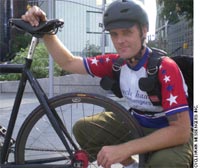Special Delivery
In this industry, looking all ways, always, is a matter of survival.
- By Marc Barrera
- Feb 01, 2009
 They’re not your average bikers. They don’t come roaring down the street in packs, polluting the air with loud noise and noxious exhaust gases. Instead of traffic rushing to make way for their passing, these bikers are constantly trying to negotiate their way around vehicles that refuse to share the road with them. They are bike messengers, and every day they perform a necessary service for little pay and no thanks in overpopulated cities that have become congested with stop-and-go traffic. But what attracts people to do this line of work?
They’re not your average bikers. They don’t come roaring down the street in packs, polluting the air with loud noise and noxious exhaust gases. Instead of traffic rushing to make way for their passing, these bikers are constantly trying to negotiate their way around vehicles that refuse to share the road with them. They are bike messengers, and every day they perform a necessary service for little pay and no thanks in overpopulated cities that have become congested with stop-and-go traffic. But what attracts people to do this line of work?
According to 16-year veteran bike messenger Kevin Bolger, 37, co-owner of the New York-based bike messenger company Cycle- Hawk Messengers Inc. (www.cyclehawknyc.com), people just have to be born to it. “It’s kind of like an adventurous thing that people want to try out, but at the end of the day it’s not really a great paying job, so it’s hard to see a future in it. Unless you really love it and are really dedicated, it’s not going to be something that you can sustain,” he said, noting the average turnaround for most bike messengers is six months. Bolger estimates the average pay is $250 to $350 per week for rookies and $500 to $700 per week for old pros.
Pedaling Safety
The most basic safety practice taken by most bike messengers is to wear a helmet. In New York and many other states, employers are required by law to provide them, but Bolger said this is often not well enforced. Many riders also choose to wear shin guards and pads.
Messengers usually provide their own bikes. Bolger cautioned the average department store bike won’t cut it for this business, but messengers also shouldn’t go get an overly fancy bike that cannot be repaired on the run. “A lot of messengers use fixed-gear bikes in the city—in New York, anyway—because there’re not a lot of hills and with fixed gears there’s just one speed. You don’t have shifters and all that stuff,” he said. “It’s just a real basic bike. That way, it’s less maintenance and less wear and tear to worry about.”
It’s essential that all messengers carry with them basic supplies and tools, including a pump, a spare tube, a patch kit, a wrench to take off the wheel, a good map, and a cell phone. Proper apparel is a necessity. For example, in winter conditions, messengers should wear extreme winter gear, such as wool socks, gloves, and Gore- Tex fabrics, or they stand little chance of lasting long on the road.
Traffic and weather are the chief on-the-job, ever-present hazards. “The traffic, the trucks, and the buses, they have low visibility, and everyone’s fighting for a space out there,” Bolger said. “If it’s raining out, all the oil slicks turn dangerous. There’re a lot of steel plates and manhole covers that are very slick. There’re pedestrians who aren’t obeying the traffic laws. It’s pretty much a free-for-all.”
Safety Training
Although some companies use a training video or gradually introduce rookies into the industry with shorter, easier deliveries, Bolger says the skill most necessary to stay safe in this industry is to be alert. “I always tell guys that you’ve got to look all ways, always,” he said. “If you’re paying 100 percent attention, you can avoid a piano falling. But if you’re staring at all the beautiful women, then you’re going to get into trouble.”
Perhaps the biggest hazard in the industry is the lack of health care benefits or insurance. By and large, the industry does not provide coverage for its workers, something that Bolger and his colleagues are trying to change through their work with the New York Bike Messenger Foundation. Established in 2003, this non-profit foundation provides, among other things, emergency funds for messengers injured or killed on the job.
“When riders do get injured, we help them out with a little bit of cash while they’re waiting for workman’s comp,” said Bolger, who serves as NYBMF president. “In the unfortunate incident where guys do die on the job, we reach out to the families and make sure that they can take care of burial services and stuff like that.”
As his young company grows, Bolger plans to take it a step further and eventually provide insurance to his employees. “We’re struggling, but when we survive and get on top of our game, then we’re going to be the best company in the city,” he said. “All the bikers are going to want to work for us because we take care of our crew. Eventually that’s going to change the industry because others are going to see that if they want the good bikers, they’re going to have to take care of them.”
This article originally appeared in the February 2009 issue of Occupational Health & Safety.